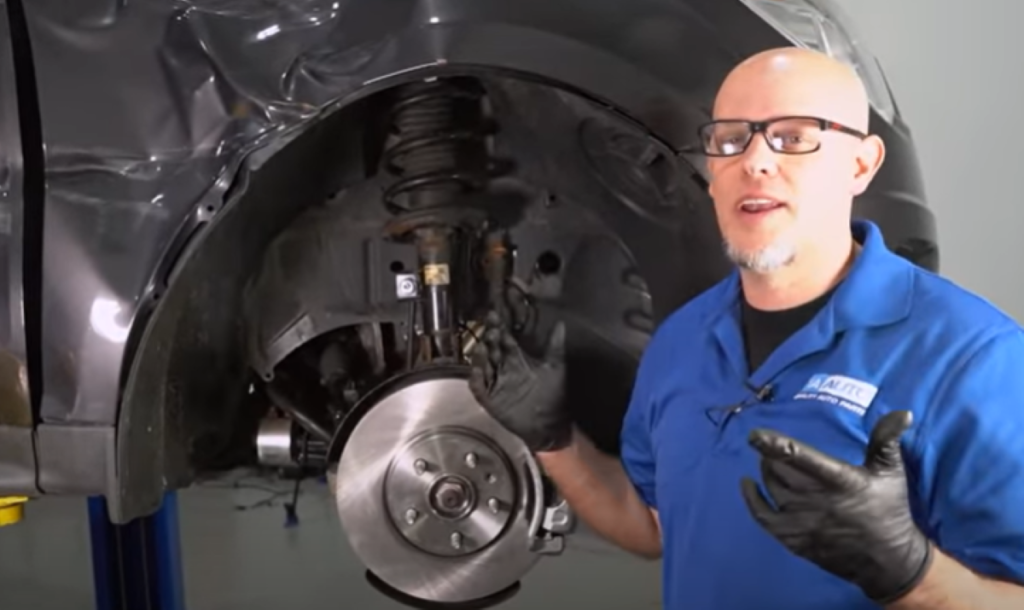If you feel your car bouncing up and down excessively while driving or when coming to a stop, it’s time to inspect your shocks and struts. This article covers 6 steps you’ll need to take to check your suspension, and in this video our mechanic Andy reviews how to diagnose the shocks and struts if you have a bouncier ride when driving.
How to Inspect a Car, Truck, or SUV That’s Bouncing When Driving

If you feel a vibration in the car or steering, and realize that as something doesn’t feel right and your car is bouncing up and down more than usual, your shocks and struts might be worn.
Why Is My Car Bouncing When I Drive?
If your car feels bouncy when driving and if you hear creaks and notice it especially when driving over bumps, your shocks and struts might be worn and they can wear out for many different reasons.
We cover what to look for and how to tell if you need new shocks or struts.
Check the Shocks and Struts on a Car Bouncing Up and Down
The strut has a coil-over spring that wraps around the strut, and it also has a boot with a little bumper. The strut attaches to the knuckle, which will pivot back and forth when you turn the wheel, and it absorbs the impact from the wheels hitting the road.
If there are shocks at the rear, checking them is a bit of a different process than checking the struts. One less part to check is the coil spring since a shock doesn’t have one.
More on the difference between shocks and struts
How to check shocks and struts in a car that’s bouncing while driving
- Look for Damage to the Body of the Strut
Look for damage to the strut body, like bends and dents. Driving over bumps and debris like rocks can damage the strut, and a good-sized bend or dent can cause it to have trouble working and need a replacement.

- Check for Fluid Leaking from the Shock or Strut
Look underneath the boot and notice the shaft that goes into the strut. If dirt and debris collects there, that could cause leaks.
If you see fluid leaking, you’ll need new struts.
A strut that’s leaking will need to be replaced. Check for oil dripping out of it or oil leaking from it to the ground. Not replacing a leaking strut can cause other suspension issues and it can wear out the tires.
More on leaking struts
- Check for Rust
A lot of rust and corrosion means the shock will need to be replaced. The shock will continue to corrode and eventually leak and break.

- Check the Bushings
The bushings can also create noise if they’re worn. Check the bushings for wear and damage, like dry-rotting and cracking. If they’re damaged, the shock can rattle around and make a noise.

- Check the Coil-Over Spring on the Strut
Worn suspension components can cause the strut to wear out faster, like the coil spring. Check the coil spring for cracks. Springs often crack at the bottom near the strut base or at the top near the strut mount. If the spring is cracked, the strut needs replacing.
- Check the Tires
If the shock absorbers aren’t doing their job by absorbing the impact from the wheels on the road, there will be more wear on the tire. The wear will be uneven and the life of the tire will be reduced if the shock absorber is damaged.
How to Remove and Replace Shocks and Struts on a Car Bouncing Up and Down
The process won’t be exactly the same for every shock or strut on every vehicle, but here’s the steps for a typical shock or strut repair.
General Steps for Removing and Installing Struts
These are general steps for removing and installing a pre-assembled strut assembly
- With the wheel on ground, loosen the lug nuts from the tire
- Raise and secure the vehicle with a jack and jack stands
- Remove the lug nuts the rest of the way
- Take off the tire
- Remove or secure any brake parts out of the way if necessary
- Remove or disconnect the ABS wire from the strut if needed
- Support the control arm with a jack if needed
- Loosen the lower bolts on the strut
- Loosen the upper bolts on the strut
- Remove the lower bolts
- Pry the strut out
- Remove the upper bolts
- Pull the strut down and out
- Reverse these steps to reinstall
General Steps for Removing and Installing Shocks
- With the tire on the ground, loosen the lug nuts
- Raise and secure the vehicle with a jack and jack stands
- With the vehicle raised, remove the rest of the lug nuts
- Remove or secure any brake parts to access the shock if needed
- Support the control arm with a jack if needed
- Remove the lower bolt from the shock
- Remove the upper bolts and bushing from the shock
- Pull the shock down and out
- Prepare the new shock
- Reverse these steps to reinstall
How-to Videos for More DIY Auto Repairs
Get more detailed, step-by-step instructions with our how-to videos. Find out how to do repairs on hundreds of models with the tips from our experienced mechanics.

Shop Parts
- Brakes & Wheel Bearing
- Steering & Suspension
- Headlights & Lighting
- Drivetrain
- Heating & Cooling
- Fuel & Emissions
More Tips
- Wheel Bearing Grinding Noise? How to Diagnose a Howling Wheel Bearing
- Why Does My Car Feel Like It’s Swaying When Turning?
- What Type of Headlights Do I Have?
- What Is a Tail Light? Tail Lights 101

